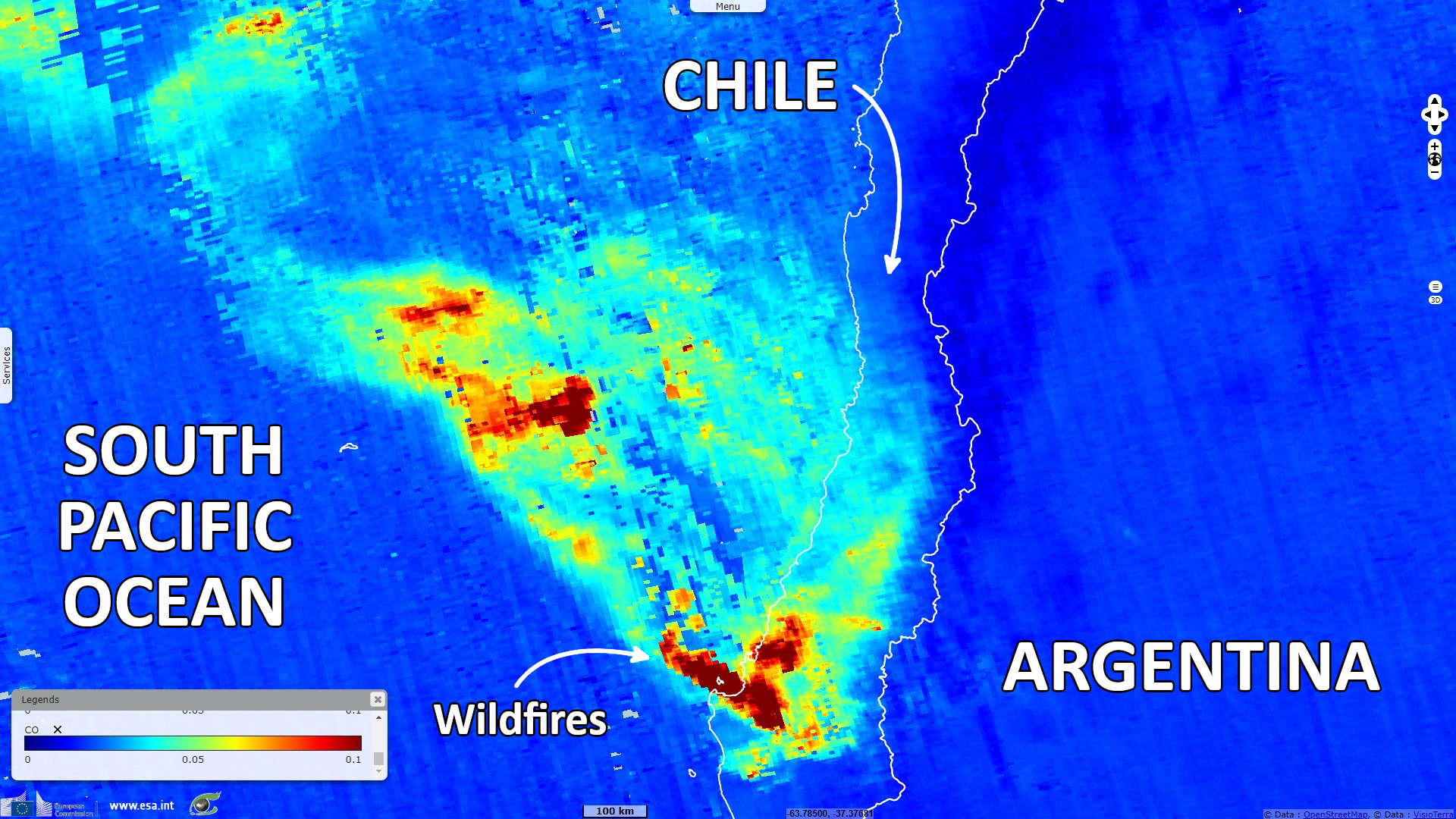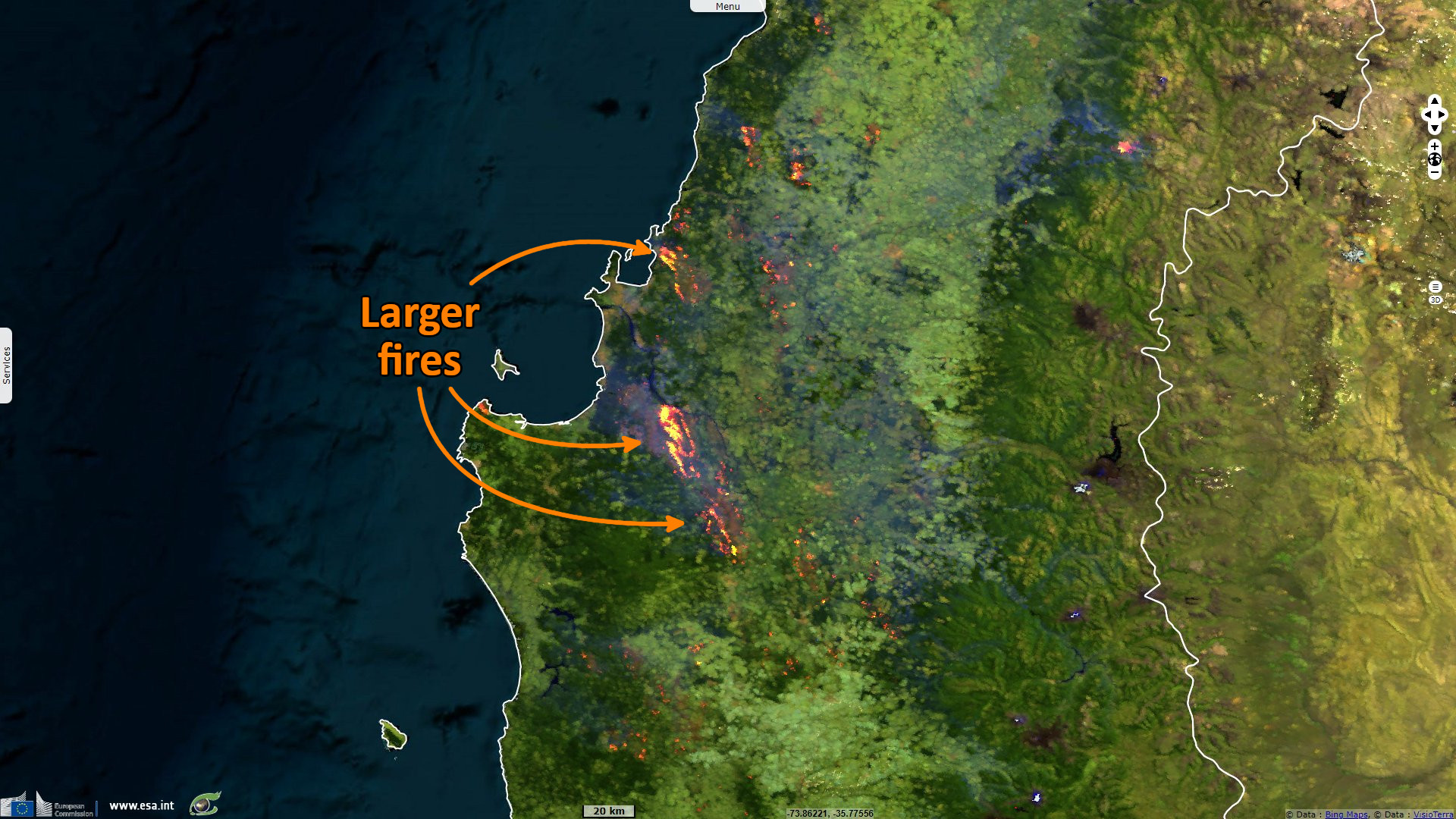Hundreds of wildfires scorch 2700 km² amid a millennial drought and record heatwave in Chile
Sentinel-2 MSI acquired on 02 February 2023 at 14:37:29 UTC
Sentinel-3 SLSTR LST & RBT acquired on 03 February 2023 at 03:08:25 UTC
...
Sentinel-3 SLSTR LST acquired on 12 February 2023 from 03:33:35 to 03:36:35 UTC
Sentinel-2 MSI acquired on 17 February 2023 at 14:37:21 UTC
Sentinel-3 SLSTR LST & RBT acquired on 03 February 2023 at 03:08:25 UTC
...
Sentinel-3 SLSTR LST acquired on 12 February 2023 from 03:33:35 to 03:36:35 UTC
Sentinel-2 MSI acquired on 17 February 2023 at 14:37:21 UTC
Keyword(s): Natural disaster, emergency, climate change, forestry, drought, heatwave, wildfire, forest fire, Chile
The hundreds of wildfires that have affected Chile coincide with a drought that has started more than 13 years ago and with an unprecedented heatwave in the south. On 6 February 2023, Sam Jones wrote for the Guardian: "Record summer temperatures of more than 40C are hampering efforts to tackle dozens of wildfires across central Chile that have killed at least 23 people, destroyed 800 homes and prompted the declaration of a state of emergency in three regions."
"Chile’s interior minister, Carolina Tohá, said 76 new fires had broken out on Friday alone, adding that the record temperatures were making it very difficult to stop the blazes spreading." "'The thermometer has reached points that we have never known until now,' Tohá said on Saturday."
Another article in the Guardian published on the same day adds: "The fires, which have consumed 270 000 hectares of land, have killed 24 people so far in south-central Chile and already made 2023 the second worst year in terms of hectares burned after the so-called 'fire storm' that hit the country in 2017." "The state National Forestry Corporation reported that as of Monday morning there were 275 active fires, of which 69 were currently being fought."
"Chile is in the grip of an over period of dry weather lasting since 2010, which the World Meteorological Organization called a 'mega drought' last year, adding that it was the longest in a thousand years and marked a major water crisis. The heatwave and strong winds have caused a rapid spread of the flames during the southern hemisphere’s summer season." "Between Sunday and Monday, aid arrived in Chile from Argentina, Spain and Mexico, while the authorities said they expected to receive new support from Brazil, Colombia, Paraguay, Peru, Portugal and Venezuela."
Catherine Osborn, the writer of Foreign Policy’s weekly Latin America Brief, sets the disaster in perspective: "Forest fires burning through south-central Chile is a regular summer phenomenon that has grown more dramatic with the mass planting of non-native eucalyptus trees and as temperatures rise. This week, the blazes became the deadliest in a decade, killing at least 26 people as of Monday."
"Scientists say the culprit for these extended hot and dry conditions is a mix of climate change and a Pacific Ocean weather pattern known as La Niña, during which stronger-than-usual winds blow warm water away from the South American zone of the Pacific. This is the third consecutive year the phenomenon has taken place. So-called triple-dip La Niñas have occurred before, but never since the globe has warmed to its current temperature of around 1.1 degrees Celsius above pre-industrial levels. (The last triple-dip La Niña ended in 2001.)"
"In addition to Argentina’s potential $15 billion agricultural export losses, neighboring Uruguay has projected $1.1 billion in lost revenue from its own ranching and farming sectors due to drought, officials estimate." "Uruguay draws much of its electricity from hydropower dams, which are now running at low capacity due to the drought. Officials resolved to buy electricity from across the border in Brazil."
"Many Argentine farmers had already altered their planting strategies in anticipation of this third consecutive dry season, delaying the date they plant seeds to wait for more rain, Pablo Mercuri of Argentina’s National Institute of Agricultural Technology told Diálogo Chino in October 2022. In recent years, both Argentina and Brazil have experienced a boom in agricultural startups that use technology to help farmers better plan their harvests. And the demand for a more stable electricity supply in the region is one reason governments have invested in research into green hydrogen, which can be used for electricity storage."
"Still, the dramatic events of recent weeks have prompted criticism that the agriculture sector—and governments—are not doing enough to mitigate the effects of and adapt to a warming planet. Latin America and the Caribbean is the region with the world’s highest portion of greenhouse gas emissions that come from agriculture, forestry, and other land use, according to the Intergovernmental Panel on Climate Change."
"In Uruguay, former President José Mujica, who is also a former agriculture minister, called for cattle ranchers to use breeds that are more heat resistant and create special paddocks for animals to endure hot weather." "In Argentina, the current government has earned criticism from environmentalists for everything from expanding natural gas extraction to allegedly not doing enough to decarbonize the agriculture sector."
The governments of Spain, the United States, Argentina, Ecuador, Brazil and Venezuela have offered help, including planes and firefighters. 11 of the victims, nearly half of the casualties reported so far, died in the town of Santa Juana in Biobio, some 500 km south of Santiago.











